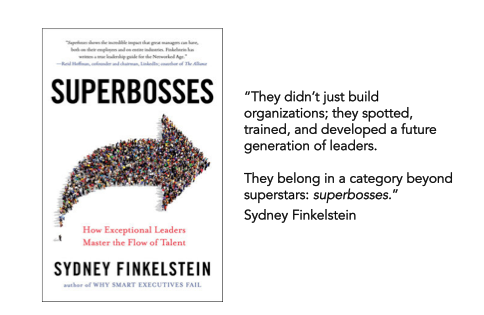

Financial reporting, supply chain disruption, and regulatory change. Capital budgets, IT project delays, and marketing spend. A board juggles these concerns and more. When caught up in details, it’s easy to lose sight of a more ethereal responsibility: how we select, manage and reward the board’s only employee.
At this time of year, boards dedicate significant time to executive compensation and CEO goal setting. Now and on any given day, CEO succession is (or should be) top of mind. Succession planning is a tough row to hoe for any board, but it is infinitely easier when the CEO is superboss.
In his latest book, Superbosses: How Exceptional Leaders Master the Flow of Talent, Tuck School of Business professor Sydney Finkelstein sheds light on what makes these leaders exceptional. Backed by 200 interviews and 10 years of research, he uses colourful examples to illustrate how the best leaders find, nurture, lead and part ways with great talent. Through surprisingly consistent hiring and management practices, these superbosses turn their organizations into leadership factories, the kinds of organizations that never scratch their heads over who should succeed the CEO.
Consider Bill Walsh, coach of the NFL San Francisco 49ers. Twenty of the NFL’s 32 head coaches trained under Walsh or someone in his coaching tree. And from 1994 until 2004, 11 Oracle executives worked closely with Larry Ellison and left the company without retiring. Nine of them went on to become CEOs, chairs, or COOs of other companies. Film director George Lucas, chef Alice Waters, musician Miles Davis, and fashion icon Ralph Lauren share the same exemplary track record for producing serious talent.
In a related Harvard Business Review article, Finkelstein points a fine point on the superboss advantage. “All have reputations as innovators who pioneered new business models, products, or services that created billions of dollars in value. But there’s one thing that distinguishes these business icons from their equally famous peers: the ability to groom talent. They didn’t just build organizations; they spotted, trained, and developed a future generation of leaders.”
Finkelstein’s research revealed three basic types of superboss and what motivates them:
- Iconoclasts – filmmaker George Lucas, Saturday Night Live’s Lorne Michaels, designer Ralph Lauren, and Intel’s Robert Noyce – fixate on their work and teach in an intuitive way as a natural outgrowth of their passion
- Glorious Bastards – executives Larry Ellison, Michael Milken, and Jay Chiat – seek fame and glory for themselves and those around them
- Nurturers – coaches Bill Walsh and Gregg Popovich, restauranteur Norman Brinker, and executive Mary Kay Ash – guide and teach proteges with their generous, externally-focused presence
How can we spot this special breed of leaders among us? Finkelstein suggests five attributes that can signal the presence of a superboss in our boardrooms.
Extremely confident
All superbosses exhibit fearlessness in furthering their agendas and ideas. They are skilled at hiring and do it intuitively, caring little for the qualifications that slow down an HR department. Too confident to feel threatened, they make protégés feel like members of an exclusive club. And this boldness extends into personal lives as well, as we see in Robert Noyce’s love of heliskiing and Norman Brinker’s brush with death in a polo match.
Finkelstein recounts a revealing joke about Larry Ellison. “What’s the difference between God and Larry Ellison? God knows he isn’t Larry Ellison.” This confidence is so unshakable that superbosses relish opportunities to be challenged by new employees, oblivious to the possibility of being wrong or outshone.
Competitive to a fault
Superbosses set extraordinarily high standards in which “perfect is good enough.” This intensity spreads as they foster competition within their own teams. For example, producer Lorne Michaels set up Saturday Night Live so that writers and performers are judged by how much of their material actually gets on the air.
Inquisitive and imaginative
By nature, superbosses are dreamers who share animated, visual fantasies as a means of inspiring others. Chef Alice Waters recounted farmers markets in France where small bistro chefs arrived at dawn to snap up the freshest peas, cauliflower, and leeks. She would close her eyes to recall a memorable glass of Sancerre. These visions created a shorthand among employees who intuitively understood the “why” underlying Waters’ methods.
Strictly committed to a core vision
All superbosses demonstrate impeccable integrity insofar as their “rather strict adherence to a core vision.” They avoid the games played by many leaders, remaining predictably true to their beliefs and sense of self. Superboss conductor Jorma Panula “only cares about the art, about the work” and avoids the political traffic that bogs down many leaders.
Unapologetically authentic
While many leaders portray an image, superbosses “let their personalities hang out.” Their unrestrained personalities come across as memorable, imparting a sense of energy on those around them. “They are spicy, interesting and exuberant – all because they make no pretenses.” The superboss’ natural openness removes anxieties that get in the way of people expressing new ideas. While other organizations stagnate amid fear and failure, George Lucas is “prepared to walk into battle and get shot at.”
Finkelstein closes with a master class in how each of us can have an impact on our organizations and communities. He prompts me to wonder what life would be like if I embraced more superboss practices and found myself surrounded by directors who live the superboss playbook.
At a minimum, I now have a more forgiving and appreciative view of the big CEO personalities I encounter. Perhaps those idiosyncrasies are not flaws, but rather drivers of top talent development in disguise.
Question: Have you worked with a superboss? How did they contribute to your performance and development?










